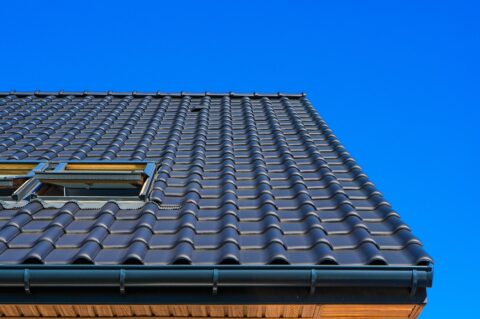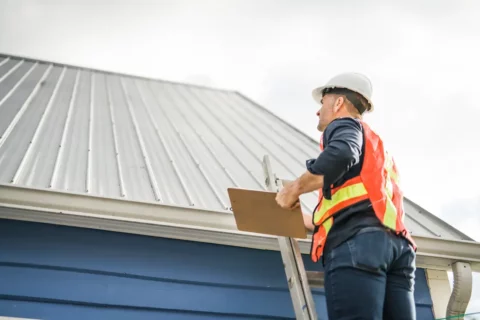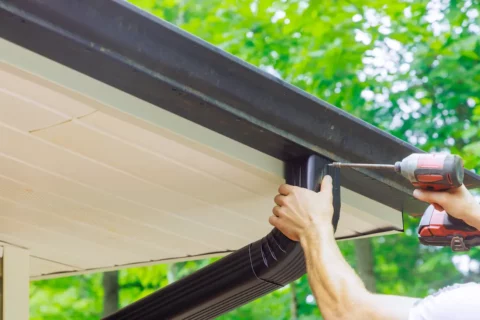
How Roof Ice Dams Form and How to Prevent Them
How Ice Dams Form and How to Prevent Them on Your Roof
Ice dams are icy ridges along roof edges that may seem harmless at first, but they can lead to significant damage if left unchecked. But what exactly causes roof ice dams, and how can you stop them before they wreak havoc on your home?
Let’s break down how these icy barriers form and the most effective ice dam prevention strategies to keep your roof safe this winter.
What Are Roof Ice Dams?
Roof ice dams are thick ridges of ice that accumulate along the edges of sloped roofs. They prevent melting snow from draining off properly.
As a result, water gets trapped behind the ice and can seep under shingles, leading to leaks that damage a home’s walls, ceilings, insulation, and other structural elements.
How Do Roof Ice Dams Form?
The formation of ice dams on roofs is primarily due to temperature variations across different sections of the roof.
Warm air from the living spaces rises and leaks into the attic due to inadequate insulation or air leaks.
This escaped heat warms the roof’s surface, causing the snow to melt. As the meltwater flows down, it reaches the colder eaves and refreezes, forming an ice barrier or dam.
Subsequently, melting snow accumulates behind this ice dam, and with nowhere to go, it seeps under shingles and into the home. Thirty-three percent of homeowners replace their roofs because of leaks.

Effective Ice Dam Prevention Strategies
Preventing ice damming involves maintaining a cold roof temperature to prevent snow from melting prematurely. Here are some effective strategies.
Proper insulation minimizes heat transfer from your living spaces to the attic. Aim for insulation levels that match or surpass local building codes to ensure energy efficiency and reduce the risk of ice dams.
Improve Attic Ventilation
Adequate ventilation helps maintain a uniform roof temperature. Installing soffit and ridge vents facilitates proper airflow, keeping the roof cool and reducing the likelihood of ice dams.
Seal Air Leaks
Check and seal any gaps or openings that enable warm air to escape into the attic. This can be achieved using caulk or weatherstripping materials.
Common problem areas include chimney gaps, recessed lighting fixtures, and vent pipes. A professional home energy audit can also help pinpoint leaks.
Regular Roof Maintenance
Keeping your roof clear of snow can reduce the amount of melt water that could refreeze. After heavy snowfalls, carefully use a roof rake to remove snow from the roof’s edge.
Be cautious not to damage shingles or roofing materials while raking. Always prioritize safety or hire professionals for this task.
Install Heat Cables
Heat cables or heat tape can be installed along roof edges and gutters to melt ice and prevent dam formation. Ensure they are installed correctly to avoid potential hazards.
Although they are effective, they are not a permanent solution. Heat cables can provide temporary relief in extreme weather conditions.
Professional Inspection
Schedule routine roof inspections with a certified roofing professional, particularly before and after winter.
A 303 Roofer, we offer comprehensive roof inspections to help you stay ahead of future problems.
Proper Downspout Drainage
Extend downspouts several feet away from your home’s foundation to prevent water accumulation and freezing near the roofline.
Maintain Clear Gutters
Clogged gutters can trap water, which can freeze and contribute to ice dam formation. Regularly clear gutters of leaves, twigs, and debris to ensure smooth water flow.
The Dangers of Roof Ice Dams
If left unaddressed, roof ice dams can lead to huge damage and costly repairs. The roof ice dams can lead to several issues:
Structural Damage
The added weight of roof ice dams can strain gutters and shingles, leading to structural damage. Water infiltration can also lead to rotting roof decking, damaged ceilings, and compromised walls.
The insidious nature of trapped meltwater extends beyond the roof’s edge. It can seep into your home. Ceiling stains, warped flooring, and peeling paint are just the initial signs. Prolonged moisture exposure weakens drywall, compromising its structural integrity, and silently attacks wooden framing, leading to long-term structural issues.
Molds and Mildew Leaks
Dampness is not just unpleasant. It’s an open invitation to mold and mildew. These microbial growths can colonize various building materials, leading to costly remediation efforts. Beyond the hefty bills for remediation, mold infestations pose a serious health hazard, especially for individuals with respiratory conditions.
Reduced Energy Efficiency
Roof ice dams are often a sign that your attic lacks proper insulation and ventilation. This means heat leaks out of your house, which drives up your heating bills in the winter. Basically, you are paying for heat that’s just escaping through the roof! Fixing the insulation and ventilation is a smart way to save money on energy costs and keep your home warmer.
FAQs
How can I tell if I have an ice dam?
Large icicles hanging from the roof’s edge, water stains on ceilings or walls, and visible ice buildup along the eaves are signs that you may have ice dams.
How much does it cost to prevent ice dams?
The cost of ice dam prevention varies depending on the specific measures you take. On average it takes $1000 to $4000. Improving the attic insulation and ventilation can be a huge investment, but it’s a worthwhile one that can save you dollars on energy bills.
Should I try removing ice dams myself?
It is best to avoid manually breaking ice dams, as this can damage your roof. Instead, use a roof rake to remove snow, apply calcium chloride ice melt, or call a professional roofing contractor for safe removal.
Conclusion
Roof ice dams are a serious threat to homeowners in colder climates. Understanding how they form and taking proactive steps for ice dam prevention is essential to protecting your home from costly damage. If you suspect an ice damming issue, do not wait until the water starts dripping from your ceiling.
At 303 Roofer, we are your local experts in protecting your home from the damaging effects of ice and snow. We are equipped to handle everything from preventive maintenance to emergency ice dam removal. Schedule your consultation with 303 Roofer today and enjoy a worry-free winter.



